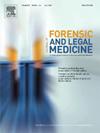Experimental modelling of internal surface laryngeal fracturing observed in fatal applied neck pressure
IF 1.2
4区 医学
Q3 MEDICINE, LEGAL
引用次数: 0
Abstract
Pathological findings can be subtle or limited, in some cases of fatal neck compression. Decalcification and en-bloc transverse histological processing using mega block cassettes, revealed a number of internal unicortical fractures to the thyroid lamina (anteriorly at the midline and posteriorly) and bilaterally in the cricoid cartilage, not visible on external inspection, which proved to be medico-legally important, in a case with very few other pathological findings, and where the application of a neck/head lock was suspected. In order to explore the nature and mechanism of these poorly recognised “buckling” type fractures, simple experiments were undertaken using 3D data printed pliable models of the thyroid and cricoid cartilages, exposed to various types of compression. The models were coated internally with hardened/cooled isomalt (a sugar baking product), to allow the pattern of surface material stress cracking to be documented as compression was applied. Compression (including isolated anterior pressure and bilateral “squeezing”) was confirmed to cause internal surface material cracking to both the thyroid and cricoid cartilage models, including in the locations found in the post mortem histology casework described above. Some surface material patterns of cracking were more commonly/typically associated with particular forms of compression. Over 90% of all the surface material cracking was obliquely or vertically orientated on the models, supporting transverse (rather than longitudinal) sectioning of the decalcified larynx as the best means for capturing these fractures within the plane of histological section, in appropriate casework.
颈部压力致死性喉内表面骨折的实验模拟
病理结果可能是微妙的或有限的,在某些情况下致命的颈部压迫。使用mega block卡带进行脱钙化和整体横向组织学处理,显示甲状腺板(中线前方和后方)和双侧环状软骨的许多内部单皮质骨折,在外部检查中未见,在其他病理发现很少的情况下,这被证明是医学-法律上重要的,并且怀疑应用颈部/头部锁定。为了探索这些鲜为人知的“屈曲”型骨折的性质和机制,使用3D数据打印的甲状腺和环状软骨柔韧模型进行了简单的实验,暴露于各种类型的压缩。模型内部涂有硬化/冷却的异麦芽糖(一种糖烘焙产品),以便在施加压缩时记录表面材料应力开裂的模式。压缩(包括孤立的前压和双侧“挤压”)被证实会导致甲状腺和环状软骨模型的内表面材料开裂,包括在上述尸检组织学病例中发现的位置。一些表面材料的开裂模式更常见/典型地与特定形式的压缩有关。超过90%的表面材料开裂在模型上呈斜向或垂直方向,在适当的情况下,支持横向(而不是纵向)切片的脱钙喉部是在组织学切片平面内捕获这些骨折的最佳方法。
本文章由计算机程序翻译,如有差异,请以英文原文为准。
求助全文
约1分钟内获得全文
求助全文
来源期刊

Journal of forensic and legal medicine
MEDICINE, LEGAL-
CiteScore
2.70
自引率
6.70%
发文量
106
审稿时长
57 days
期刊介绍:
The Journal of Forensic and Legal Medicine publishes topical articles on aspects of forensic and legal medicine. Specifically the Journal supports research that explores the medical principles of care and forensic assessment of individuals, whether adult or child, in contact with the judicial system. It is a fully peer-review hybrid journal with a broad international perspective.
The Journal accepts submissions of original research, review articles, and pertinent case studies, editorials, and commentaries in relevant areas of Forensic and Legal Medicine, Context of Practice, and Education and Training.
The Journal adheres to strict publication ethical guidelines, and actively supports a culture of inclusive and representative publication.
 求助内容:
求助内容: 应助结果提醒方式:
应助结果提醒方式:


